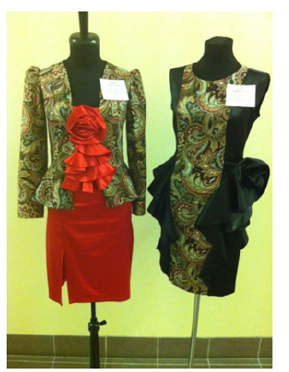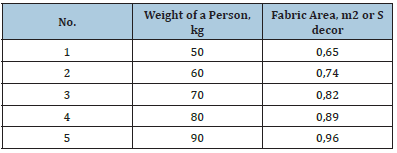- Submissions

Full Text
Trends in Textile Engineering & Fashion Technology
Formula Dress
Ivanov KG*, Ivanova EA and Deligioz AV
St. Petersburg State University of Industrial Technology and Design, St. Petersburg, 191186, Russia
*Corresponding author:Konstantin Ivanov, St. Petersburg State University of Industrial Technology and Design, St. Petersburg, 191186, Russia
Submission: April 13, 2023; Published: April 20, 2023

ISSN 2578-0271 Volume 8 Issue3
Opinion
Garments that have a harmonious form and have the features of the author’s style, which distinguishes it from the widely disseminated copies of mass fashion, can be compared with art objects. Their contemplation promotes well-being, mood, and consequently, human health.
There was a person who could tell what piece of music was on a vinyl record by looking at the track on it.
Russian writer I.A. Bunin, in response to a question about how he writes his stories, replied: “I hear a sound.” We can say that the emotions and feelings of the authors are encrypted in the works of art. This can be attributed to the work of couturier.
Artists, writers, composers themselves may not be aware of this. For viewers and listeners, this peculiar handwriting of the author brings novelty, difference. It is difficult to understand it, but it attracts attention and makes paintings, music, clothes characteristic of this author.
At the end of the 19th century, the Russian mathematician Pafnuty Lvovich Chebyshev announced in Paris that he would give a lecture on the mathematical foundations of cutting clothes. All Parisian couturiers gathered for this lecture. Chebyshev began the lecture like this: “For simplicity, let’s imagine that a person has the shape of a ball”.
Why in the form of a sphere? The man is more like a cylinder. But from an aesthetic point of view, the sphere is the most perfect geometric figure. If this perfection is reflected in clothes, it will have harmonious features inherent in the models of famous couturiers.
It is necessary to calculate the surface area of the sphere that a person would occupy if he was turned into a ball. Coding the sphere as one of the most symmetrical and perfect figures can create a certain charm in clothes.
Formula derivation:

ρ=1000 kg/m3 is approximately equal to the density of the human body, m is the mass of a person.
Examples of area values for clothing features for various masses of models calculated using this formula (Figure 1) (Table 1).
Figure 1:The photo shows models of dresses made accordingly.

Table 1:Examples of area values for clothing features for various masses of models calculated using this formula.

This surface area is small, so let’s assume that it should be the area of body parts not covered by clothing (legs, arms, neckline, etc.) or the area of decoration (lace, patterns, colored inserts in a plain dress, etc.). Or see [1] decor area.
For sportswear, this area can be occupied by various inscriptions, drawings or other colors, etc. It all depends on the imagination of the fashion designer. The photo shows models of dresses made according to this idea by Anna Valerievna Deligioz. In these models, the areas of fabrics of different colors are approximately the same and are calculated according to the above formula.
References
- Chagina LL, Smirnova NA, Voronova EM (2011) Expansion of the range of linen knitwear through the use of non-traditional methods of decoration. Science Magazine: Technology of light industry 11(1): 79 -82.
© 2023 Ivanov KG. This is an open access article distributed under the terms of the Creative Commons Attribution License , which permits unrestricted use, distribution, and build upon your work non-commercially.
 a Creative Commons Attribution 4.0 International License. Based on a work at www.crimsonpublishers.com.
Best viewed in
a Creative Commons Attribution 4.0 International License. Based on a work at www.crimsonpublishers.com.
Best viewed in 







.jpg)






























 Editorial Board Registrations
Editorial Board Registrations Submit your Article
Submit your Article Refer a Friend
Refer a Friend Advertise With Us
Advertise With Us
.jpg)






.jpg)














.bmp)
.jpg)
.png)
.jpg)










.jpg)






.png)

.png)



.png)






